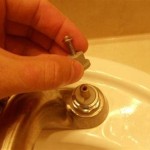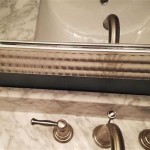White Rectangular Porcelain Bathroom Sink Drain: A Comprehensive Guide
The white rectangular porcelain bathroom sink drain is a ubiquitous feature in modern bathrooms, prized for its clean aesthetic, durability, and functionality. This combination of form and function makes it a popular choice for homeowners, designers, and builders alike. Understanding the various aspects of this common bathroom fixture, from its materials and design to its installation and maintenance, is crucial for making informed decisions regarding bathroom renovations and repairs.
The prevalence of the white rectangular porcelain bathroom sink drain stems from its inherent compatibility with a broad range of bathroom styles. The color white provides a neutral canvas that complements diverse color palettes and design themes, from minimalist modern to classic traditional. The rectangular shape adds a contemporary touch, offering a clean and streamlined appearance that contrasts with more ornate or rounded sink designs. Furthermore, the use of porcelain, a durable and non-porous material, ensures longevity and ease of cleaning, contributing to the fixture's overall practicality.
Materials and Manufacturing
The primary material in a white rectangular porcelain bathroom sink drain is, as the name suggests, porcelain. Porcelain is a ceramic material made by heating mixtures of clay, kaolin, feldspar, and silica to high temperatures, typically between 1,200 and 1,400 degrees Celsius. This process, known as firing, vitrifies the mixture, resulting in a hard, dense, and non-porous material. The high firing temperatures also contribute to porcelain's resistance to staining, scratching, and chemical damage.
The manufacturing process typically involves shaping the porcelain clay mixture into the desired rectangular form using molds. Once shaped, the porcelain undergoes a glazing process. The glaze is a thin layer of liquid glass that is applied to the surface of the porcelain and then fired again. This glaze provides a smooth, glossy finish that enhances the aesthetic appeal of the sink while also providing an additional layer of protection against water damage and staining. The white color is achieved by adding pigments to the glaze during the manufacturing process.
The drain component of the sink assembly, though often overshadowed by the porcelain body, is equally important. The drain is typically constructed from metal, with brass being a common choice owing to its corrosion resistance. Chrome or brushed nickel finishes are often applied to the brass drain to match other bathroom fixtures, such as faucets and showerheads. The drain mechanism, whether a pop-up, lift-rod, or grid drain, is also made of metal and contributes to the overall functionality of the sink.
The quality of the materials and manufacturing processes directly affects the longevity and performance of the white rectangular porcelain bathroom sink drain. Higher-quality porcelain will be less prone to chipping and cracking, while a well-constructed drain mechanism will operate smoothly and resist corrosion. Therefore, it is advisable to choose sinks from reputable manufacturers that adhere to stringent quality control standards.
Design Considerations and Style Compatibility
The rectangular shape of the sink offers a distinct aesthetic advantage in contemporary bathroom designs. Its clean lines and geometric form create a sense of order and sophistication. The rectangular design also often maximizes the usable basin area, providing more space for washing and other bathroom activities. The combination of the rectangular shape and the white color creates a visually light and airy feel, making it suitable for both small and large bathrooms.
The versatility of the white color allows the sink to blend seamlessly with a wide range of bathroom styles. In minimalist bathrooms, the white rectangular sink reinforces the clean and uncluttered aesthetic. In more traditional bathrooms, it can provide a subtle contrast against darker cabinets and countertops, adding a touch of modernity. The white color also serves as a blank canvas, allowing other bathroom elements, such as colorful tiles or patterned wallpaper, to take center stage.
Different mounting styles further influence the overall look and feel of the sink. Undermount sinks, where the sink is installed beneath the countertop, create a seamless and integrated look. Vessel sinks, which sit on top of the countertop, make a bolder statement and can add a touch of architectural flair. Wall-mounted sinks offer space-saving advantages and create a minimalist aesthetic. The choice of mounting style depends on the overall design vision for the bathroom and the available space.
The faucet selection is another crucial design consideration. Chrome faucets are a classic choice that complements the white sink and provides a timeless appeal. Brushed nickel faucets offer a softer and more contemporary look. Black or brass faucets can add a touch of drama and contrast. The style of the faucet should be in harmony with the overall design of the bathroom, and the height and reach of the faucet should be suitable for the sink's dimensions to prevent splashing and ensure comfortable use.
Installation and Maintenance
The installation of a white rectangular porcelain bathroom sink drain requires careful planning and execution. It is generally recommended to hire a qualified plumber for the installation, especially if it involves altering existing plumbing lines. However, understanding the basic steps involved can help homeowners effectively communicate with the plumber and ensure the installation is done correctly.
The first step is to shut off the water supply to the sink. The existing sink and drain assembly need to be removed, and the countertop opening may need to be adjusted to accommodate the new rectangular sink. The new sink is then carefully positioned and secured to the countertop using appropriate adhesives or mounting hardware. The drain assembly is installed, ensuring that all connections are watertight. The water supply lines are connected to the faucet, and the drainpipe is connected to the drain tailpiece.
Once the installation is complete, it is crucial to check for leaks. Run the water and inspect all connections for any signs of drips or seepage. If leaks are detected, tighten the connections or replace any faulty components. Proper installation is essential to prevent water damage and ensure the long-term performance of the sink.
Maintaining a white rectangular porcelain bathroom sink drain is relatively straightforward. Regular cleaning with a mild soap and water is sufficient to remove most stains and dirt. Avoid using abrasive cleansers or scouring pads, as they can scratch the porcelain surface. Stubborn stains can be removed with a diluted solution of bleach or vinegar, but it is important to rinse thoroughly afterward.
The drain should also be cleaned regularly to prevent clogs. Hair and other debris can accumulate in the drainpipe, leading to slow drainage or complete blockage. A simple drain snake or a mixture of baking soda and vinegar can be used to clear minor clogs. For more severe clogs, a professional plumber may be needed.
Periodically inspect the drain assembly for any signs of corrosion or damage. Replace any worn or damaged components to prevent leaks and ensure proper drainage. Keeping the sink and drain clean and well-maintained will prolong its lifespan and preserve its aesthetic appeal.
Furthermore, consider the environment when choosing cleaning products. Opt for eco-friendly and biodegradable cleaners to minimize the impact on the water system and the environment. Avoid harsh chemicals that can damage the porcelain finish and harm aquatic life.
In the event of chips or cracks in the porcelain, consider professional repair services. While DIY repair kits are available, they may not provide a seamless or durable repair. A professional can assess the damage and recommend the most appropriate repair method, ensuring that the sink retains its aesthetic and functional integrity.
By understanding the materials, design, installation, and maintenance aspects of a white rectangular porcelain bathroom sink drain, homeowners can make informed decisions and ensure that this essential bathroom fixture remains a functional and aesthetically pleasing part of their homes for many years to come. The seemingly simple fixture requires a holistic understanding for optimal utilization and longevity.

Rectangle Ceramic 23 White Undermount Bath Sink W Overflow Drain

Eago Ba131 20 White Rectangular Porcelain Bathroom Sink With Overflow

Kraus Elavo 21 1 8 In Rectangular Porcelain Ceramic Undermount Bathroom Sink White With Overflow Drain Kcu 242 The Home Depot

Novatto Rectangular 23 In Drop Porcelain Bathroom Sink White With Overflow Drain Oil Rubbed Broe Np Di2185511orb The Home Depot

Top Elavo Modern White Porcelain Ceramic Bathroom Sink Kraus

Lordear 28in Undermount Bathroom Sink Rectangular Pure White Vitreous Ceramic Lavatory Vanity Vessel Sinks

Bathroom Sink Rectangle Deep Bowl Pure White Porcelain Ceramic Lavatory Vanity Basin With Overflow Com

Lordear Porcelain Vanity Sink White Ceramic Undermount Rectangular Modern Bathroom 20 In X 14 The Sinks Department At Com

Ruvati 24 X 16 Inch Bathroom Vessel Sink White Rectangular Above Counter Porcelain Ceramic Rvb2416 Usa

Stylish White Porcelain Undermount Rectangular Bathroom Sink With Overflow Drain 24 In X 16 P 208 Rona
Related Posts







